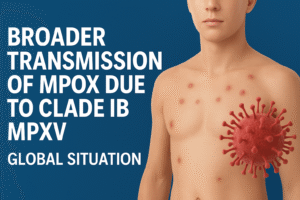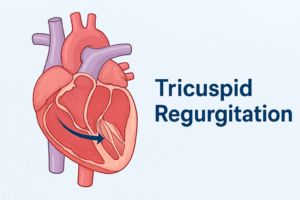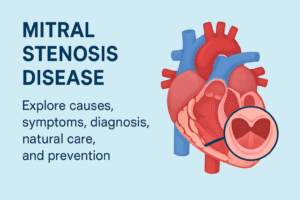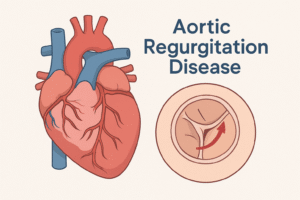Heart failure is a long-term medical condition in which the heart is unable to pump enough blood to meet the body’s needs for oxygen and nutrients. Unlike cardiac arrest, where the heart suddenly stops, in heart failure the heart still beats but its pumping ability is weaker. This condition develops either gradually over time or, in some cases, quite suddenly.
Heart failure can affect the left side, the right side, or both sides of the heart. When the left side is affected, breathing difficulties are more common, while right-sided failure often causes fluid build-up and swelling in the body.
What Causes Heart Failure?
There are many reasons why the heart may become weak or overworked. Some of the most common causes include –
- Coronary Artery Disease (CAD): This is the most frequent cause. Narrowed or blocked arteries reduce blood flow, gradually weakening the heart muscle.
- Heart Attack (Myocardial Infarction): A sudden blockage in an artery damages part of the heart, reducing its pumping ability.
- High Blood Pressure (Hypertension): Extra strain makes the heart work harder, thickening the muscle at first but eventually weakening it.
- Heart Valve Problems: When valves are leaky or stiff, the heart must work harder, which can lead to failure.
- Cardiomyopathy: Diseases of the heart muscle, whether from genetics, infections, alcohol, or drug use, reduce the heart’s strength.
- Arrhythmias: Persistent fast, slow, or irregular heartbeats can disturb efficient pumping.
- Congenital Heart Defects: Structural heart problems present at birth may progress to failure later in life.
- Lung Diseases: Chronic lung issues like COPD or pulmonary hypertension strain the right side of the heart.
- Other Risk Factors: Conditions like thyroid disorders, diabetes, obesity, severe anemia, excessive alcohol use, and certain viral infections can contribute.
Stages of Heart Failure
Doctors classify heart failure into four stages, described by the American College of Cardiology and the American Heart Association –
- Stage A – At Risk: No symptoms yet, but risk factors like diabetes, high blood pressure, or family history are present.
- Stage B – Pre-Heart Failure: Structural heart disease is detected (such as after a heart attack), but symptoms are still absent.
- Stage C – Symptomatic Heart Failure: Clear symptoms like breathlessness, fatigue, or swelling begin to appear.
- Stage D – Advanced Heart Failure: Symptoms persist even at rest, often requiring advanced treatments such as heart transplant or supportive devices.
Symptoms of Heart Failure
Symptoms usually develop slowly but can appear suddenly if the condition worsens. Common signs include –
- Breathing problems such as shortness of breath during activity or at rest, difficulty breathing while lying down, or sudden nighttime breathlessness.
- Fatigue and weakness due to poor oxygen delivery.
- Swelling in the legs, ankles, feet, or abdomen caused by fluid retention.
- Irregular heartbeat or fluttering sensations.
- Coughing or wheezing, sometimes with pink, frothy sputum.
- Rapid weight gain, frequent urination at night, or swelling in the neck veins.
- Reduced ability to exercise, loss of appetite, nausea, or even confusion in older adults.
Generally, left-sided failure leads to more respiratory symptoms, while right-sided failure is linked with fluid retention and swelling.
How Is Heart Failure Diagnosed?
Doctors rely on a mix of patient history, physical exams, and tests.
- History: They ask about symptoms such as fatigue, swelling, and shortness of breath, along with risk factors like diabetes or past heart attack.
- Physical exam: Doctors look for swelling, listen for abnormal heart sounds, and check for lung crackles caused by fluid.
- Tests:
- Blood tests, especially BNP or NT-proBNP, indicate heart stress.
- Echocardiogram (heart ultrasound) is the most important test, showing pumping efficiency and valve function.
- ECG detects rhythm problems or past heart attacks.
- X-rays reveal heart enlargement or lung fluid.
- Advanced tests like MRI, stress tests, or angiography may be needed.
Managing Heart Failure Without Medicines
Lifestyle plays a powerful role in easing symptoms and slowing disease progression. Key steps include –
- Diet: Limit salt to reduce fluid retention and sometimes restrict fluids in advanced cases. Focus on fruits, vegetables, lean proteins, and whole grains while avoiding processed foods, excess alcohol, and too much caffeine.
- Exercise: Light activities like walking or swimming improve stamina. Cardiac rehab programs help patients build strength safely. Heavy exertion should be avoided.
- Daily Monitoring: Weighing yourself daily helps spot fluid build-up early. Gaining more than two kilos in a couple of days can be a warning sign.
- Lifestyle changes: Quit smoking, limit alcohol, manage stress with yoga or meditation, and ensure good sleep.
- Supportive therapies: Oxygen or CPAP machines may be advised for those with low oxygen or sleep apnea.
- Education: Patients should learn to identify warning signs, keep follow-up appointments, and stay updated on vaccines like flu and pneumonia.
Preventing Heart Failure
Prevention is often more effective than treatment. Strategies are divided into three categories –
- Primary prevention: For those at risk but without disease. This means controlling blood pressure, blood sugar, cholesterol, avoiding smoking, limiting alcohol, staying active, and maintaining a healthy weight.
- Secondary prevention: For people with existing heart disease but not yet in failure. This involves following treatments strictly, reducing salt intake, and reporting new symptoms early.
- Tertiary prevention: For diagnosed patients. The focus here is preventing worsening, avoiding hospitalizations, monitoring daily weight, and following fluid/salt restrictions carefully.
Risk Factors
Certain health conditions and lifestyle choices increase the risk of heart failure. These include coronary artery disease, high blood pressure, diabetes, heart attacks, heart valve problems, arrhythmias, thyroid disease, chronic kidney disease, smoking, obesity, physical inactivity, excessive alcohol use, and high-salt diets. Risk also increases with age, family history, sleep apnea, and chronic stress.
The Global Impact
Heart failure affects over 64 million people worldwide. It is especially common in people over 70. Despite treatments, almost half of all patients die within five years of diagnosis. It also causes massive healthcare costs, mainly due to repeated hospitalizations.
Quality of life is often poor because of constant fatigue, breathlessness, and reduced independence. High-income countries face challenges due to aging populations, while low- and middle-income countries struggle with late diagnoses and limited treatments. By 2030, global cases are expected to rise by about 30%. Prevention through better control of hypertension, diabetes, and obesity is crucial.
Frequently Asked Questions
1. Is heart failure the same as a heart attack?
No. A heart attack is a sudden event caused by a blocked artery, while heart failure is a long-term condition where the heart gradually weakens.
2. Can heart failure be cured?
It usually cannot be fully cured, but with proper treatment and lifestyle changes, symptoms can be managed and progression slowed.
3. What foods should I avoid if I have heart failure?
Avoid high-salt foods, processed meals, fried foods, excess caffeine, and alcohol. Focus on a balanced, low-sodium diet.
4. Can exercise help heart failure?
Yes, light to moderate exercise helps improve stamina and circulation. However, patients should avoid overexertion and ideally join supervised cardiac rehab programs.
5. Who is most at risk for heart failure?
Older adults, people with high blood pressure, diabetes, obesity, or a history of heart disease are most at risk. Lifestyle factors like smoking and poor diet also increase chances.
6. How can I detect early warning signs?
Look for shortness of breath, swelling in legs or abdomen, unusual fatigue, rapid weight gain, or persistent cough. Reporting these early can prevent worsening.






